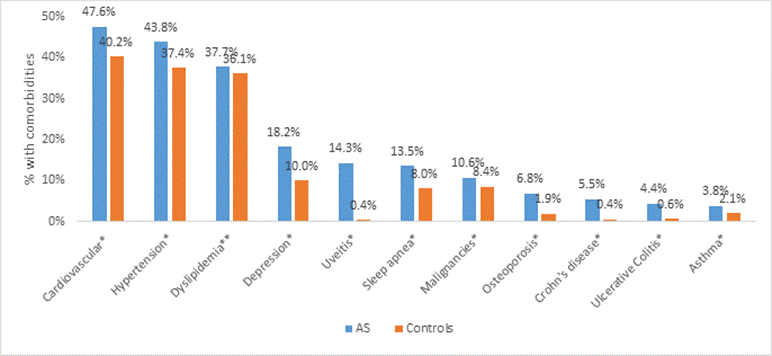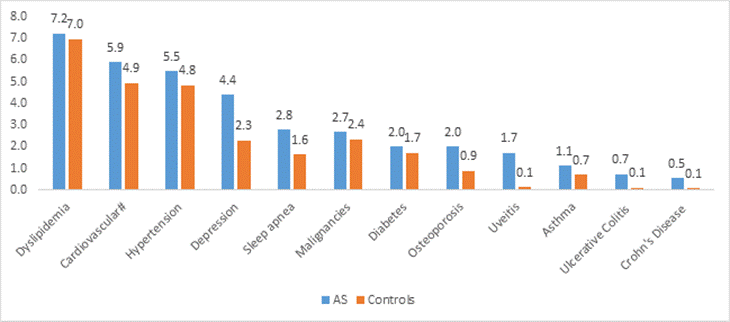Session Information
Session Type: ACR Poster Session A
Session Time: 9:00AM-11:00AM
Background/Purpose:
Comorbidities associated with ankylosing spondylitis (AS) have been inadequately studied in American populations. This study used a large US national claims database to compare prevalence and incidence of comorbidities of AS patients and general population.Methods:
Adults with ≥1 inpatient or 2 outpatient diagnoses of AS (ICD-9-CM 720.0) in 1/1/2008 – 6/30/2014 were extracted from MarketScan Commercial and Medicare Databases. Of those identified, patients with ≥1 AS diagnosis in 2013 were included in the study, with the first AS diagnosis in 2013 set as the index date. Patients had ≥12 months pre-period and were followed for ≥12 months until patient death or the end of the study (6/30/2015). The prevalence of comorbidities was evaluated in a prevalent AS cohort. The incidence of new comorbidities (not present in a 24-month pre-period) was evaluated in an incident AS cohort with newly diagnosed AS (no AS in the 12-month pre-period). General population included patients with no AS diagnosis in 2007-2015 and were matched to the AS patients on calendar year, age, gender, and geographic region.Results:
The prevalent AS cohort had 6,679 AS patients and 19,951 matched general population (mean age: 50.8 years for AS vs. 51.7 for general population; male: 60.5% vs. 60.8%; mean length of follow up period: 2.0 vs. 2.0 years). Compared with general population, a significantly higher proportion of AS patients had cardiovascular disease, hypertension, dyslipidemia, depression, sleep apnea, uveitis, malignancies, Crohn’s disease, ulcerative colitis, osteoporosis, and asthma (Figure 1). The proportion of patients with diabetes was similar between AS patients and general population (11.8% vs. 13.6%, p=0.343). The incident AS cohort included 6,370 newly diagnosed AS patients and 14,998 matched general population. Incidence rates of newly diagnosed comorbidities were higher in incident AS patients than in general population (Figure 2). Figure 1. Proportion of Patients with Comorbidities: Prevalent AS vs. General Population
*p<0.001; ** p=0.017. Figure 2. Incidence Rates per 100 Person-Years of Top New Comorbidities for Incident AS vs. General Population
Conclusion: AS patients had significantly more comorbidity burden than general population in the US. Understanding these comorbidity profiles will help evaluate the impact of comorbid conditions on patients’ health outcomes and healthcare utilizations. Future research is needed to determine optimal screening and management strategies for comorbidities in AS patients.
To cite this abstract in AMA style:
Walsh J, Song X, Kim G, Park J. Prevalence and Incidence of Comorbidities in Patients with Ankylosing Spondylitis Versus General Population [abstract]. Arthritis Rheumatol. 2016; 68 (suppl 10). https://acrabstracts.org/abstract/prevalence-and-incidence-of-comorbidities-in-patients-with-ankylosing-spondylitis-versus-general-population/. Accessed .« Back to 2016 ACR/ARHP Annual Meeting
ACR Meeting Abstracts - https://acrabstracts.org/abstract/prevalence-and-incidence-of-comorbidities-in-patients-with-ankylosing-spondylitis-versus-general-population/

